Amphibian Information in KRIS Ten
Mile
KRIS
Web Background Pages: Sensitive Amphibians

Ten Mile River Basin amphibian
data come from annual electrofishing of twenty four aquatic vertebrate monitoring
stations since 1993 that are currently maintained by Hawthorne Timber Company.
The electrofishing surveys were conducted at the same time each year, and would
offer high quality data for interpretation of local population trends over the
last nine years except that the focus of the surveys was salmonid fishes and,
according to HTC staff, the consistency of effort toward capturing amphibians
varied. Consequently, these data are used in KRIS Ten Mile only to note
various amphibian species present and distributed among the 24 Ten Mile River
Basin stations, and to show possible trends based on repeating patterns in the
data among several sites. No study has yet examined the relationships between
riparian habitat change in the Ten Mile River Basin and these sensitive amphibian
data, but such relationships may be explored in KRIS Ten Mile by comparing USFS
vegetation data to amphibian data at particular sites. Studies
in the Mattole Basin have examined linkages between riparian conditions
and amphibian populations, and these represent the best information available
on the topic in northwestern California.
KRIS Ten Mile River
charts derived from data provided by Hawthorne Timber Company
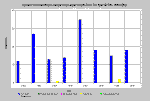 |
This chart shows
the number of amphibians captured at site SFT9 which is located near the
headwaters of the South Fork Ten Mile River. Twelve tailed frog
were captured at this site in 1998, the largest capture of this rare amphibian
in the entire Ten Mile River Basin electrofishing data set. Three
other sites detected presence of tailed frog, including the most upstream
sites of the Middle Fork: CFT1 and CFT8. One tailed frog at
NFT7 (Buckhorn Creek) in 1994 was the only detection in the North Fork
Subbasin. Tailed frog were not found at any site in more than two
years. The sites where tailed frog were found had some of the coolest
water temperatures in the basin.
|
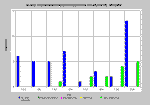 |
Yellow-legged
frog were the second most abundant amphibian species in the electrofishing
capture record. The data for site NFT9 on the North Fork Ten Mile
River, represents one of several sites exhibiting a pattern of increasing
Yellow-legged frogs abundance. See also data from NFT4, SFT5, and SFT7. |
The following charts represent
amphibian data in three tributaries of the South Fork, where a pattern of decline
for Pacific Giant Salamander is repeated. A similar pattern is evident
for Bald Hill Creek in the North Fork, and Lower Bear Haven Creek in the Middle
Fork.
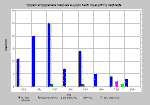 |
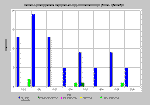 |
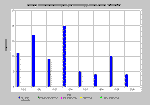 |
| Number
of amphibians captured in Lower Smith Creek |
Number
of amphibians captured in Lower Campbell Creek, . |
Number
of amphibians captured in Churchman Creek. |
In addition to the number
of animals captured, amphibian data is presented in KRIS Ten Mile as density
and biomass for each site. Biomass may be a particularly good companion
metric for monitoring Pacific giant salamander and other species where individual
size varies greatly. Biomass and density values for amphibian data in
the Ten Mile River Basin should not be used for comparison among sites because
they under-represent true values in some cases. This bias is particularly
large where high fish abundance saturated netters with their primary task of
monitoring fish.
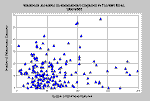 |
This scatter plot
illustrates what correlation may exist between the number of steelhead
present at a site and the number of Pacific giant salamanders captured
at that site. The chart shows 251 points representing each site from 1993
to 2000. One could hypothesize a positive correlation based on the similar
habitat requirements of these two species, or a deviation from positive
based on interspecies competition. The chart does show how, according
to Hawthorne Timber Company field staff, when steelhead were very abundant
(>120), Pacific giant salamanders were less likely to be captured due
to the saturation of netters and the priority placed on capturing salmonids.
|
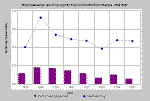 |
This
chart shows mean Pacific giant salamander and steelhead trout density from
24 electrofishing stations throughout the Ten Mile River Basin. Assuming
that the relationship between capture bias for Pacific giant salamanders
and steelhead numbers (as shown in above chart) is similar among years,
the pattern of Pacific giant salamander density in this chart is indicative
of a population decline. |

References
Ambrose, J., and D. Hines.
1998. Ten Mile River Watershed 1997 Instream Monitoring Results. Georgia-Pacific
West Inc. dba The Timber Company. Fort Bragg, CA. 51 pp.
Welsh, H.H. Redwood Sciences
Laboratory, Arcata, CA.





![]()



![]()
![]()